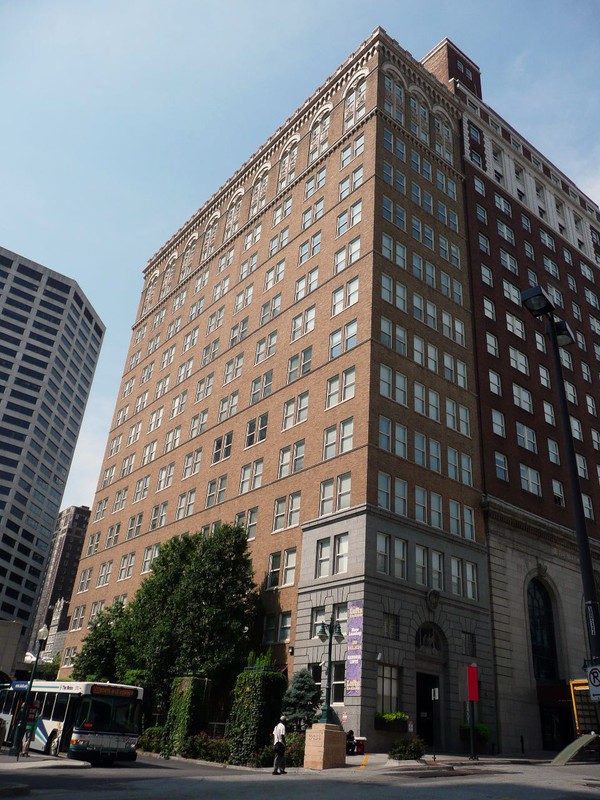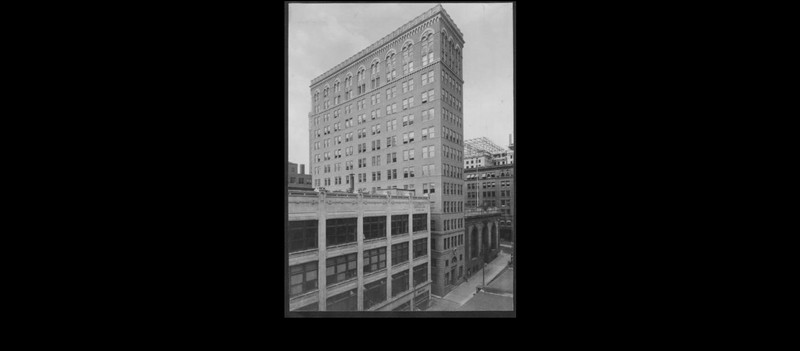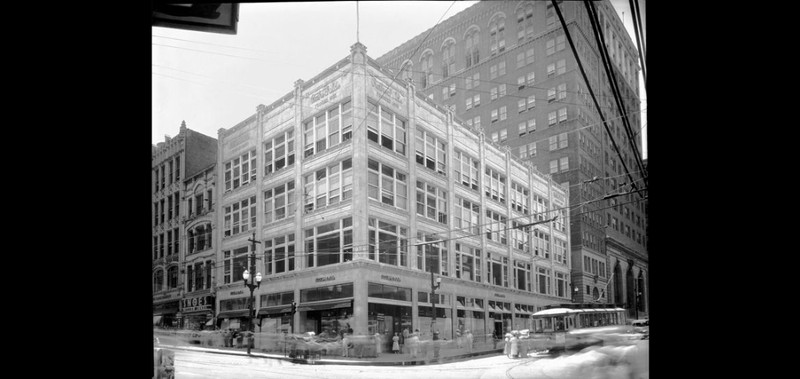Land Bank Building
Introduction
Text-to-speech Audio
One of the cornerstone buildings of Kansas City's Financial District, this structure was completed in 1924 for the Kansas City Joint Stock Land Bank, the nation's fifth to receive a Charter under the 1916 Federal Farm Loan Act. This law provided guaranteed loans to farmers in recognition of the growing expenses farmers faced as agriculture became more reliant on advanced equipment and larger landholdings, as well as the unique challenges farmers faced when they tried to secure loans compared to other businesses. The building's design was recognized with the 1924 Business District's Gold Medal for architecture. For many years, Rothschild's department store was located east of this building while the New England National Bank remains to the west. The former bank across the street is now home to the Kansas City Public Library.
Images
Land Bank Building in Kansas City. To the right is the New England National Bank

1928 photo of the Land Bank Building in Kansas City.

Rothschild's department store was located next to the Land Bank Building at 10th and Main streets.

Backstory and Context
Text-to-speech Audio
The Land Bank Building was created in the wake of the 1916 Federal Farm Loan Act, a law that was aimed to provide relief to the farming community from decades of dealing with exceedingly high interest rates on loans. Several variables led to the substantial increase in agricultural development and resultant commodification of the soil (farming for profit) west of the Mississippi during the late nineteenth century. Some factors include railroad expansion, the 1862 Homestead Act, and a myth that "the rain follows the plow" (a belief that cultivation of soil increased rainfall by moistening the soil and thus the local atmosphere). Similar to most commercial enterprises (including agriculture) that arose during the rapid western expansion of the nineteenth century, proximity to the railroad proved necessary for success. The closer a farm was to a railroad, the more expensive the land. Farmers also had to buy farm equipment and materials which also increased in price as they increased in complexity and size.
As a result of changes in farming, current and prospective farmers relied on loans. In many cases, the only collateral they could offer banks involved their land, but farmers hoped to use their future crops as collateral, something banks recognized was a risk. As a result, farmers struggled to obtain the loans they needed to expand operations. The result was both an increase in average yield per acre during the late nineteenth century and a decline in the total number of families engaged in farming. The country was becoming increasingly urban each decade, and a financial crisis shortly before the turn of the twentieth century forced some to close farms which threatened stability in agriculture. Given the equal representation of every state regardless of population in the U.S. Senate, there was support in Congress to do something to help ease the financial plight of farmers. Woodrow Wilson signed The Federal Farm Loan Act in 1916, which led to the creation of a dozen Land Banks throughout the country. The government chose to place one of the banks in Kansas City because of the city's connection to agriculture and because of its growth into a major financial center with an established banking system.
Architects Keene and Simpson dually catered the building design to meet the needs of the banking community and fit on a narrow lot. The slim, tall building included mezzanine levels (intermediate floors located between main floors) on the first and twelfth floors, used by banking tenants. In addition to tackling the challenges connected to function, they successfully addressed the building's form with a highly regarded Italian Renaissance design. Other touches included tall windows that allowed for ample natural lighting, mahogany and marble finishings, Venetian blinds, unique furniture, and a filtered and cooled drinking water system. The combination of all their efforts resulted in the architects receiving the 1924 Business District's Gold Medal.
While the Land Bank program across the nation largely enjoyed success, a scandal in 1927 resulted in the Federal Courts placing the Kansas City Land Bank being placed in a Federal receivership because of its mismanagement by the Land Bank's first president, Walter S. Cravens. In addition to his role at the Land Bank, Cravens served as president of the Missouri Joint Stock Land Bank, director of the Safe Deposit Company of Kansas City, director of the Denver Joint Stock Land Bank, and the director of the American Underwriting Company. Cravens parlayed his business assets into nearly five million dollars, but his nefarious loan dealings led to his eventual federal indictment, the bank being placed in federal receivership, and the bank's eventual sale in 1931. The Land Bank operated until 1945 before transitioning to various commercial and business uses tied to several ownership changes. Similar to many other downtown buildings, the structure now serves as apartment lofts.
Sources
Buckley, Robert J. "The Federal Farm-Loan Act." Journal of Political Economy 25, no. 2 (1917): 129-147.
Shaw, Christopher W. "'Tired of Being Exploited': The Grassroots Origin of the Federal Farm Loan Act of 1916. Agricultural History 1, no. 92 (2018): 512–540.
Steinberg, Ted. Down to Earth: Nature's Role in American History. New York: Oxford University Press, 2009.
Trachtenberg, Alan. The Incorporation of America: Culture and Society in the Gilded Age. New York: Hill & Wang, 2007.
Wiebe, Robert H. The Search for Order: 1877 - 1920. New York: Hill & Wang, 1967.
Uguccioni, Ellen J. "Registration Form: Land Bank Building." National Register of Historic Places. mostateparks.com. 1984. https://mostateparks.com/sites/mostateparks/files/Land%20Bank%20Bldg.pdf.
By Mwkruse - Own work, CC BY-SA 3.0, https://commons.wikimedia.org/w/index.php?curid=42275239
Kansas City Public Library, Pendergast Years: https://pendergastkc.org/collection/9130/10000922/land-bank-building
https://kchistory.org/image/rothschilds-department-store-building?solr_nav%5Bid%5D=dabe4cfe22763c8e9b48&solr_nav%5Bpage%5D=0&solr_nav%5Boffset%5D=9
